AMD Zen 2 Microarchitecture Analysis: Ryzen 3000 and EPYC Rome
by Dr. Ian Cutress on June 10, 2019 7:22 PM EST- Posted in
- CPUs
- AMD
- Ryzen
- EPYC
- Infinity Fabric
- PCIe 4.0
- Zen 2
- Rome
- Ryzen 3000
- Ryzen 3rd Gen
CCX Size
Moving down in node size brings up a number of challenges in the core and beyond. Even disregarding power and frequency, the ability to put structures into silicon and then integrate that silicon into the package, as well as providing power to the right parts of the silicon through the right connections becomes an exercise in itself. AMD gave us some insight into how 7nm changed some of its designs, as well as the packaging challenges therein.
A key metric given up by AMD relates to the core complex: four cores, the associated core structures, and then L2 and L3 caches. With 12nm and the Zen+ core, AMD stated that a single core complex was ~60 square millimeters, which separates into 44mm2 for the cores and 16mm2 for the 8MB of L3 per CCX. Add two of these 60mm2 complexes with a memory controller, PCIe lanes, four IF links, and other IO, and a Zen+ zeppelin die was 213 mm2 in total.
For Zen 2, a single chiplet is 74mm2, of which 31.3 mm2 is a core complex with 16 MB of L3. AMD did not breakdown this 31.3 number into cores and L3, but one might imagine that the L3 might be approaching 50% of that number. The reason the chiplet is so much smaller is that it doesn’t need memory controllers, it only has one IF link, and has no IO, because all of the platform requirements are on the IO die. This allows AMD to make the chiplets extremely compact. However if AMD intends to keep increasing the L3 cache, we might end up with most of the chip as L3.
Overall however, AMD has stated that the CCX (cores plus L3) has decreased in size by 47%. That is showing great scaling, especially if the +15% raw instruction throughput and increased frequency comes into play. Performance per mm2 is going to be a very exciting metric.
Packaging
With Matisse staying in the AM4 socket, and Rome in the EPYC socket, AMD stated that they had to make some bets on its packaging technology in order to maintain compatibility. Invariably some of these bets end up being tradeoffs for continual support, however AMD believes that the extra effort has been worth the continued compatibility.
One of the key points AMD spoke about with relation to packaging is how each of the silicon dies are attached to the package. In order to enable a pin-grid array desktop processor, the silicon has to be affixed to the processor in a BGA fashion. AMD stated that due to the 7nm process, the bump pitch (the distance between the solder balls on the silicon die and package) reduced from 150 microns on 12nm to 130 microns on 7nm. This doesn’t sound like much, however AMD stated that there are only two vendors in the world with technology sufficient to do this. The only alternative would be to have a bigger bit of silicon to support a larger bump pitch, ultimately leading to a lot of empty silicon (or a different design paradigm).
One of the ways in order to enable the tighter bump pitch is to adjust how the bumps are processed on the underside of the die. Normally a solder bump on a package is a blob/ball of lead-free solder, relying on the physics of surface tension and reflow to ensure it is consistent and regular. In order to enable the tighter bump pitches however, AMD had to move to a copper pillar solder bump topology.
In order to enable this feature, copper is epitaxially deposited within a mask in order to create a ‘stand’ on which the reflow solder sits. Due to the diameter of the pillar, less solder mask is needed and it creates a smaller solder radius. AMD also came across another issue, due to its dual die design inside Matisse: if the IO die uses standard solder bump masks, and the chiplets use copper pillars, there needs to be a level of height consistency for integrated heat spreaders. For the smaller copper pillars, this means managing the level of copper pillar growth.
AMD explained that it was actually easier to manage this connection implementation than it would be to build different height heatspreaders, as the stamping process used for heatspreaders would not enable such a low tolerance. AMD expects all of its 7nm designs in the future to use the copper pillar implementation.
Routing
Beyond just putting the silicon onto the organic substrate, that substrate has to manage connections between the die and externally to the die. AMD had to increase the number of substrate layers in the package to 12 for Matisse in order to handle the extra routing (no word on how many layers are required in Rome, perhaps 14). This also becomes somewhat complicated for single core chiplet and dual core chiplet processors, especially when testing the silicon before placing it onto the package.
From the diagram we can clearly see the IF links from the two chiplets going to the IO die, with the IO die also handling the memory controllers and what looks like power plane duties as well. There are no in-package links between the chiplets, in case anyone was still wondering: the chiplets have no way of direct communication – all communication between chiplets is handled through the IO die.
AMD stated that with this layout they also had to be mindful of how the processor was placed in the system, as well as cooling and memory layout. Also, when it comes to faster memory support, or the tighter tolerances of PCIe 4.0, all of this also needs to be taken into consideration as provide the optimal path for signaling without interference from other traces and other routing.


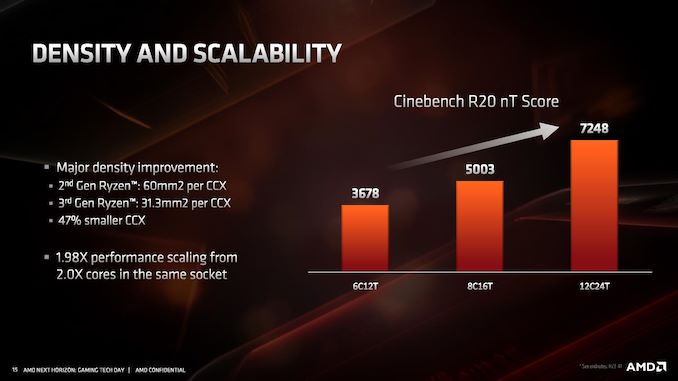
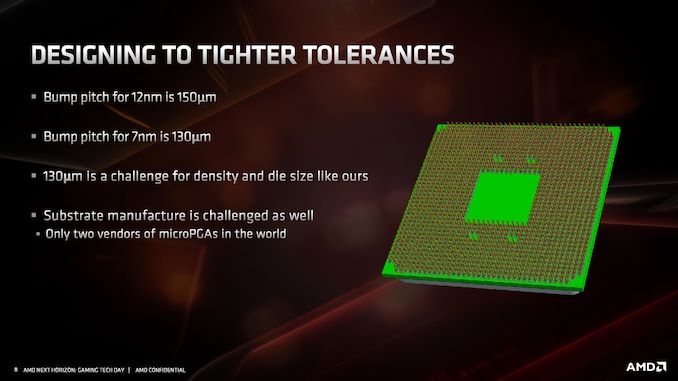
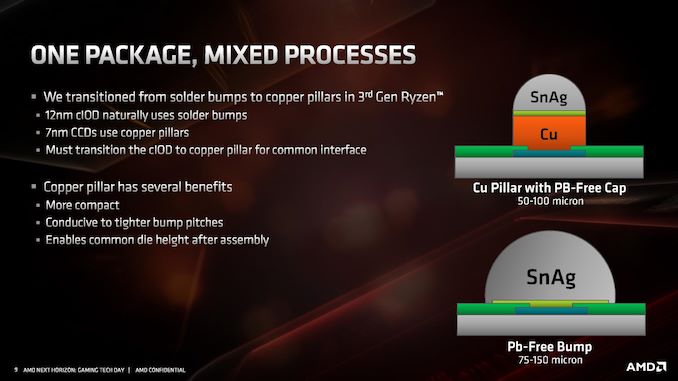
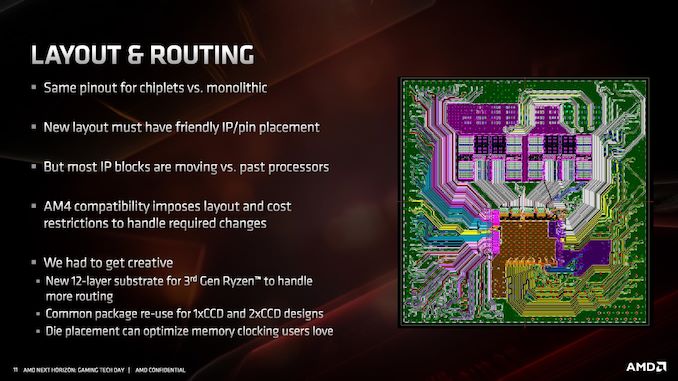
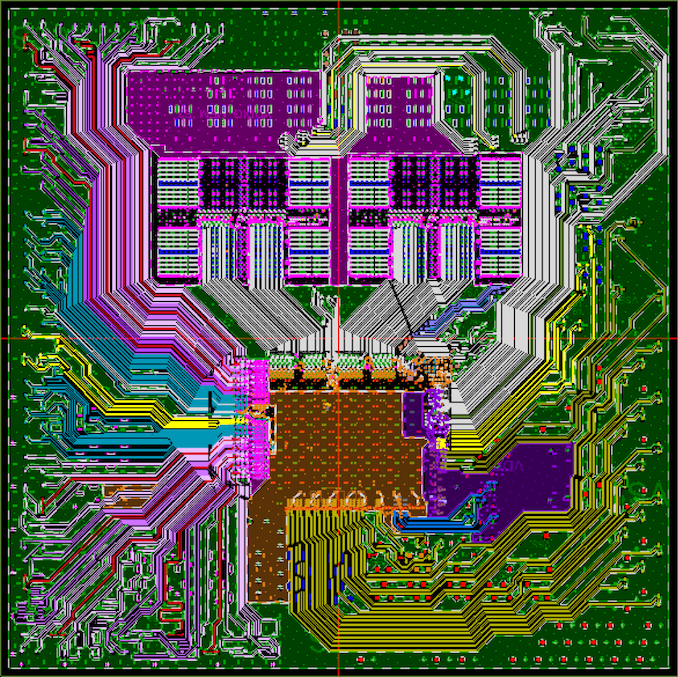








216 Comments
View All Comments
Ratman6161 - Friday, June 14, 2019 - link
Better yet, why even bother talking about it? I read these architecture articles and find them interesting, but I'll spend my money based on real world performance.Notmyusualid - Sunday, July 7, 2019 - link
@ Ratman - aye, I give this all passing attention too. Hoping one day another 'Conroe' moment lands at our feet.RedGreenBlue - Tuesday, June 11, 2019 - link
The immediate value at these price points is the multithreading. Even ignoring the CPU cost, the motherboard costs of Zen 2 on AM4 can be substantially cheaper than the threadripper platform. Also, keep in mind what AMD did soon after the Zen 1000 series launch, and, I think, Zen 2 launch to a degree. They knocked down the prices pretty substantially. The initial pricing is for early adopters with less price sensitivity and who have been holding off upgrading as long as possible and are ready to spring for something. 3 months or so from launch these prices may be reduced officially, if not unofficially by 3rd parties.RedGreenBlue - Tuesday, June 11, 2019 - link
*Meant to say Z+ launch, not Zen 2.Spoelie - Wednesday, June 12, 2019 - link
To be fair, those price drops were also partially instigated by CPU launches from Intel - companies typically don't lower prices automatically, usually it is from competitive pressure or low sales.just4U - Thursday, June 13, 2019 - link
I don't believe that's true at all S. Pricing was already lower than the 8th gen Intels and the 9th while adding cores wasn't competing against the Ryzens any more than the older series..sing_electric - Friday, June 14, 2019 - link
That's true, but by most indications, if you want the "full" AM4 experience, you'll be paying more than you did previously because the 500-series motherboards will cost significantly more - I'm sure that TR boards will see an increase, too, but I think, proportionately, it might be smaller (because the cost increase for say, PCIe 4.0 is probably a fixed dollar amount, give or take).mode_13h - Tuesday, June 11, 2019 - link
Huh? There've been lots of Intel generations that did not generate those kinds of performance gains, and Intel has not introduced a newer product at a lower price point, since at least the Core i-series. So, I have no idea where you get this 10-15% perf per dollar figure.Irata - Tuesday, June 11, 2019 - link
So who does innovate in your humble opinion ?Looking at your posts, you seem to confuse / jumble quite a lot of things.
Example TSMC: So yes, they are giving AMD a better manufacturing that allows them to offer more transistors per area or lower power use at the same clock speed.
But better perf/ $ ? Not sure - that all depends on the price per good die, i.e. yields, price etc. all play a role and I assume you do not know any of this data.
Moores law - Alx already covered that...
As for the 16 core - what would the ideal price be for you ? $199 ? What do the alternatives cost (CPU + HSF and total platform cost).
If you want to look a price - yes, it did go up compared to the 2xxx series, but compared to the first Ryzen (2017), you do get quite a lot more than you did with the original Ryzen.
1800x 8C/16T 3,6 Ghz base / 4 Ghz boost for $499
3900x 12C/24T 3.8 Ghz base / 4,6 Ghz boost for $499
Now the 2700x was only $329, but its counterpart the 3700x has the same price, roughly the same frequency but a lower power consumption and supposedly better performance in just the range you mention.
Spunjji - Tuesday, June 11, 2019 - link
Nice comprehensive summary there!